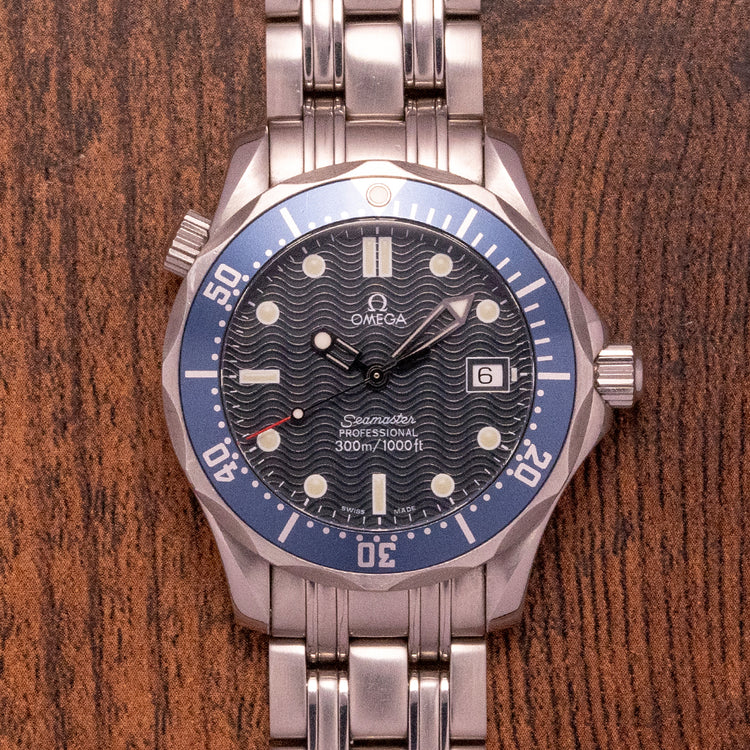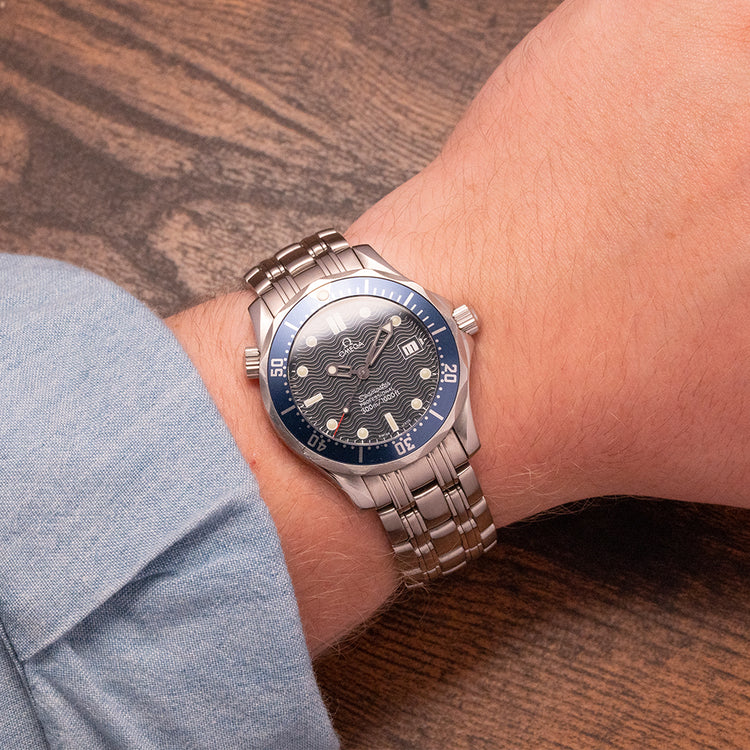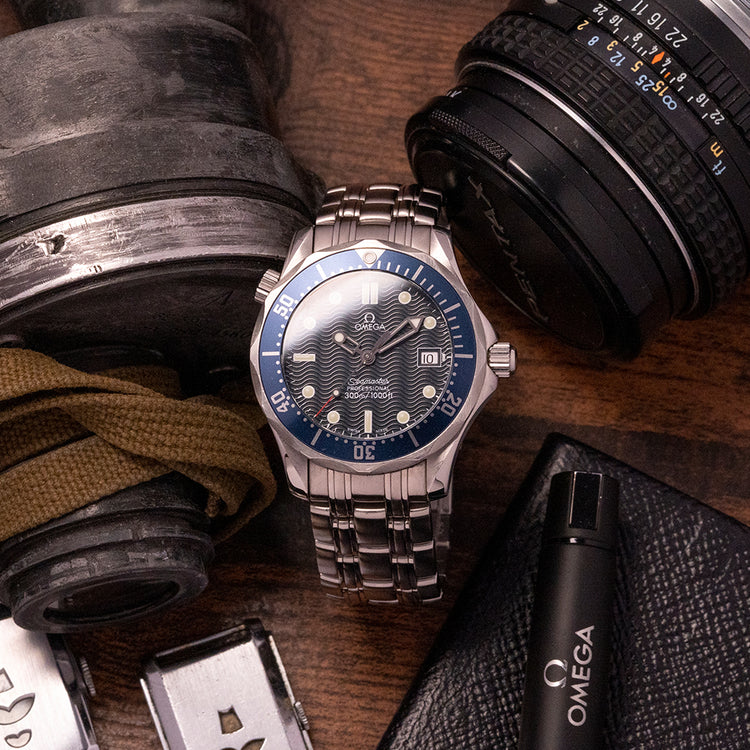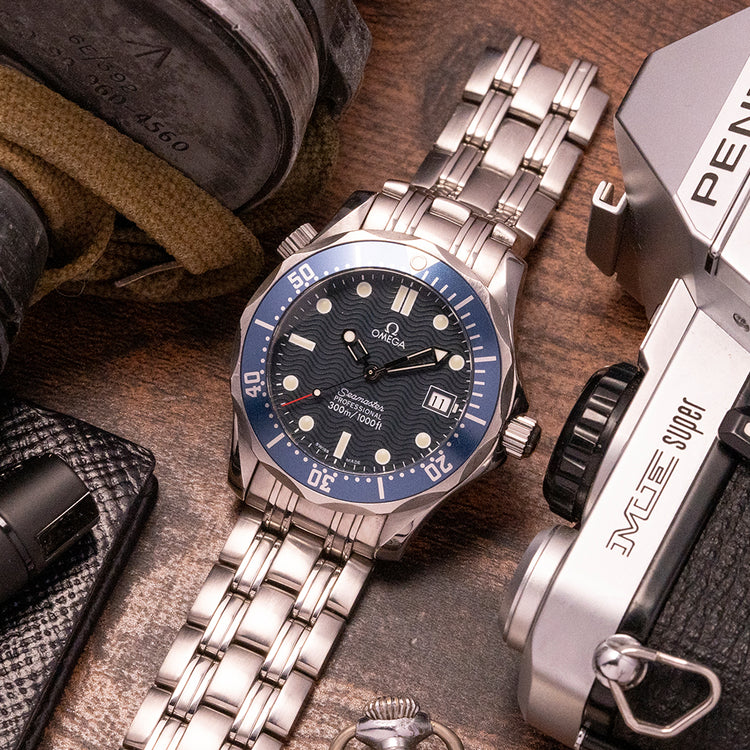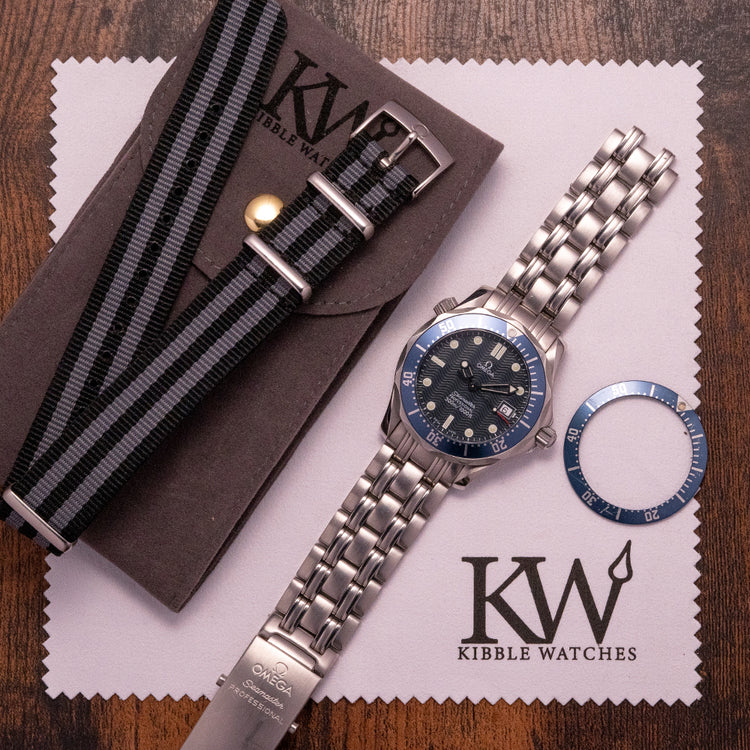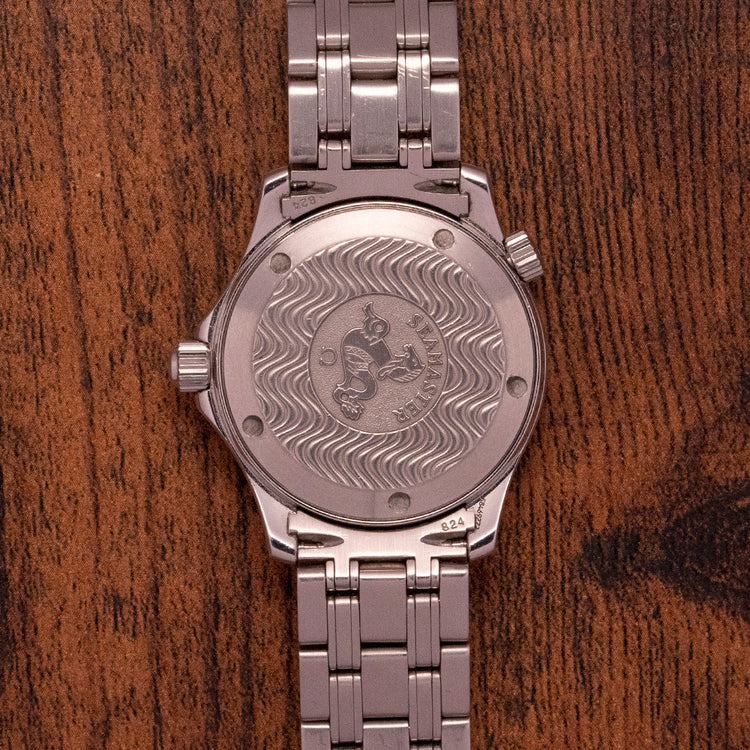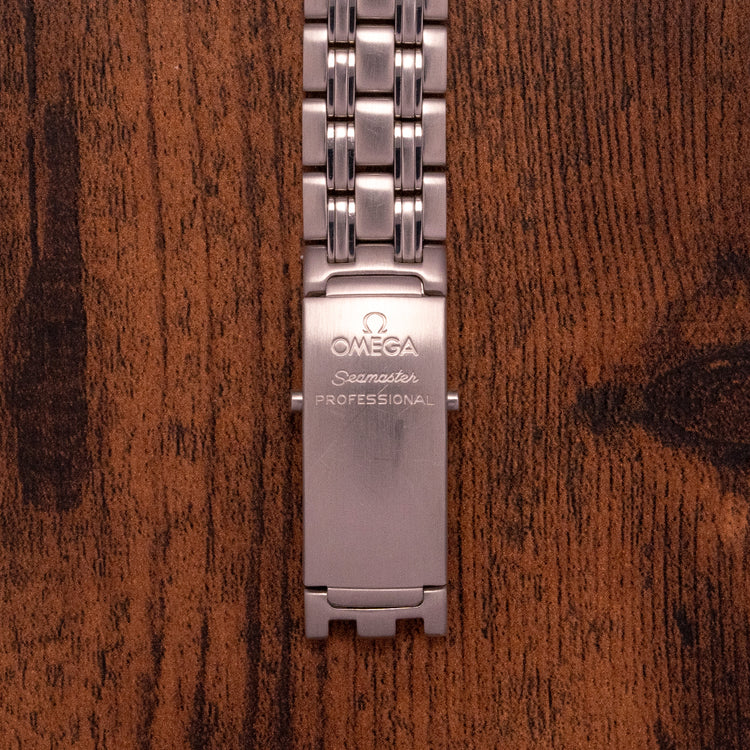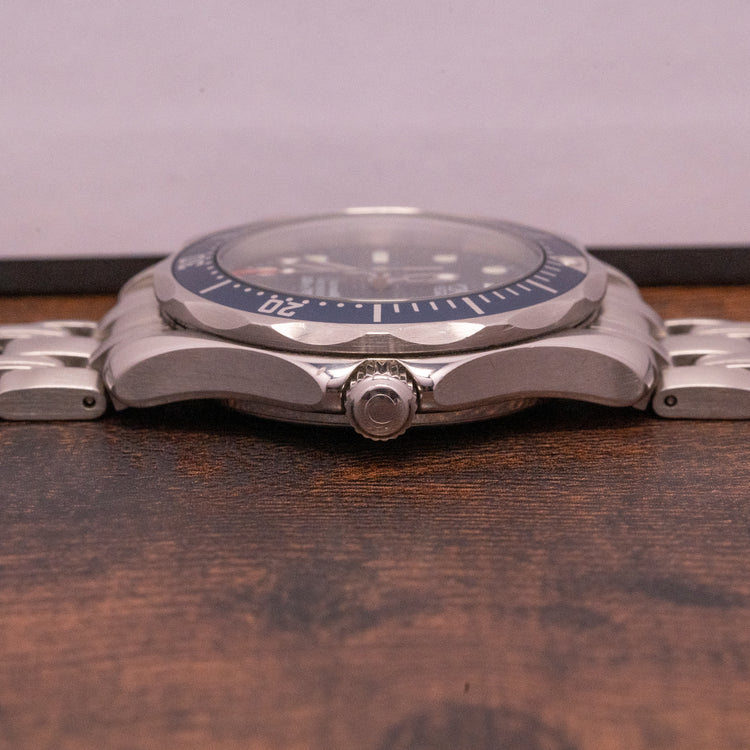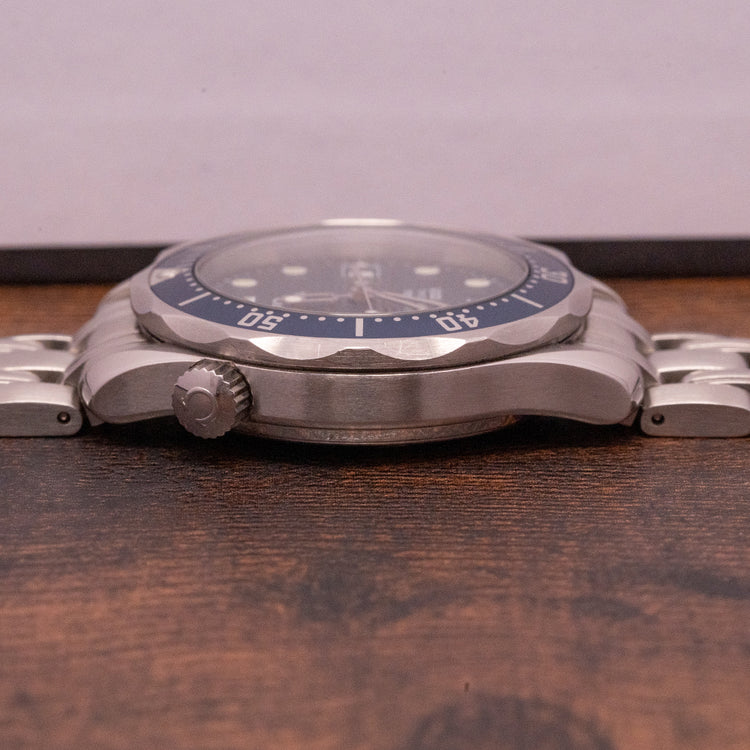More Information
Description
More
Less
The Watch
Here we have a 1990s Omega Seamaster 300M Quartz Mid-Size 2561.80.00 with a 36mm polished and brushed stainless steel case, twisted lugs with a lug-to-lug length of 42.5mm and a case thickness of 10.5mm giving the watch an impressive wrist presence. On the right side is a signed screw-down crown protected by crown guards and at 10 o’clock on the left side a helium escape valve. The unidirectional bezel has scalloped sides for extra grip and a blue dive insert with silver numerals and markings. A domed Sapphire crystal sits above a deep blue dial with a dynamic wavy pattern, an outer minute track has disc and baton indexes coated in luminance marking the hours, and at 3 o’clock a framed date window, skeletonized sword hands have lume tips complemented by a red-tipped lollipop sweeping second-hand, at 12 o’clock we have the Omega motif and at 6 o’clock “Seamaster Professional 300m/100ft'' is printed underneath. On the reverse a screw-down case back with engraved waves and a polished Hippocampus in the centre, a seahorse that represents Neptune the God of the sea, it was conceived by Pierre Borie after seeing a picture of Neptune riding a chariot pulled by seahorses, it is the reason why the seahorses are wearing a bridle, first seen on the Seamaster in 1958. Inside a Quartz Omega Cal. 1538, 6 jewels, based on the ETA 255.461. The watch comes fitted on its 18mm Omega stainless steel bracelet with a signed push button-released folding clasp plus an additional 18mm Omega Bond NATO strap and an additional blue bezel insert.
Points of Mention
This watch is sold “Watch Only” and therefore without its original Omega box and Omega booklet. The watch comes paired with its original 18mm Omega stainless steel bracelet with Omega signed push button-release clasp, plus an additional 18mm Omega Bond NATO strap and an additional blue bezel insert. The watch is from Circa. Late 1990s / Early 2000s. The watch is in worn condition but is overall in fair condition, as seen by the photographs. A full case and bracelet refurb can be provided on request at an additional cost. The watch comes with our 12-Months NON-Waterproof Warranty.
For more photos see here - https://drive.google.com/drive/folders/1Jq25P0Oae6-IlvoqYToWFS4Ks44UdlSx?usp=drive_link
4K YouTube video, skip to 11:37 - https://youtu.be/KKgfz8w73jo
Personal Note
I have said it many times, these smaller 36mm models wear incredibly well on the wrist, I have a 7-inch wrist and I truly do prefer how this 36mm wears over the larger size and I am seeing a lot more of my customers try smaller watches and realise that it works perfectly well! The value of this quartz Seamaster 300 is incredible, to think you can get an Omega Seamaster in general at this price is amazing, so snap it up whilst you can!
Specification
Lugs : 18mm
Condition : Pre-Owned
Box & Papers : None
Case Material : Stainless Steel
Warranty : 12-Months Non-waterproof Warranty
The Brand
They were formerly known as the La Generale Watch Co. in 1848 founded by Louis Brandt in La Chaux-de-Fonds. When he died in 1879, his sons carried on his dream. In 1880 they moved to 96 Rue Jakob-Stampfli where they remain today. The brothers produced their first mass-produced calibre, the Labrador In 1885. Just a few years later in 1892, they produced the first minute-repeater. In 1903 they renamed the company Omega until 1982 when they officially changed their name to Omega SA. During WW1 Omega watches were used as official timekeepers for the Royal Flying Corps and the US Army. In 1930, Omega and Tissot merged together to form Société Suisse pour l'Industrie Horlogère (SSIH) In 1931, another group was formed - Allgemeine Schweizerische Uhrenindustrie AG (ASUAG). Where SSIH was primarily French-speaking, ASUAG was founded by the more German-speaking members of the Swiss watch industry. In 1948 they introduced the first edition of one of its most symbolic watches: the Seamaster. Omega first introduced the Constellation in 1952. At the time it was Omega's flagship timepiece. The first models had a Cal. 354 bumper movement in them. Later in 1955, Omega introduced the Automatic Cal. 50x, followed in 1959 by the Cal.55x (no date) and 56x (date) versions. Many of the Constellations came with pie-pan dials, diamond indexes, and fancy lug configurations. All the gold Constellations of that time have the Observatory of Geneva's hand engraved on the back. The stainless steel and stainless steel/gold versions had a gold medallion on the back with the Observatory of Geneva. The eight stars above the Observatory stand for the many exploits of Omega in the world Chronometer competition. Celebrating the fact that all Constellations are Chronometer Certified. In 1962, when astronaut Wally Schirra wore a Speedmaster on his Mercury Sigma 7 Mission, making it the first Omega watch to enter space. After rigorous tests, NASA used Omega for all their Apollo missions including the 1969 Moon landing of Apollo 11. Today Omega is still an astronaut's first choice. In 1969, President Nixon famously said it was “too valuable” and turned down the first-ever all-gold Speedmaster Professional Deluxe. As a response to the ever-growing threat of electronic watches to the manufacturers of mechanical watches, Omega and many Swiss brands such as Rolex and Patek Philippe formed Centre Electronique Horologer (CEH). Prototypes began to appear in 1967 with their production starting in 1968. Then In 1972, Omega introduced the reference, 198.030, which included the Omega calibre 1250, a ‘tuning-fork electronic movement which was made under licence from Bulova. Later we saw a merger of SSIH and ASUAG into SMH, or Société de Microélectronique et d’Horlogerie. This merger took place in 1983. In 1992, the company acquired Blancpain, and in 1998 it officially rebranded itself from SMH to the Swatch Group. Then, in 1999, they purchased and integrated Breguet into the Swatch Group.
Points of Mention
More
Less
Personal Note
More
Less
Specification
More
Less
Movement : Quartz Omega Cal. 1538
Age : Circa. 1990s
Year : Circa. 1990s
Case Size : 36mm
Case Thickness : 10.5 mm
Lug to Lug : 42.5mm
Lugs : 18mm
Condition : Pre-Owned
Box and Papers : None
Case Material : Stainless Steel
Warranty : 12-Months Non-waterproof Warranty
The wrist model's wrist size is 7inch
About Omega
More
Less
Description
The Watch
Here we have a 1990s Omega Seamaster 300M Quartz Mid-Size 2561.80.00 with a 36mm polished and brushed stainless steel case, twisted lugs with a lug-to-lug length of 42.5mm and a case thickness of 10.5mm giving the watch an impressive wrist presence. On the right side is a signed screw-down crown protected by crown guards and at 10 o’clock on the left side a helium escape valve. The unidirectional bezel has scalloped sides for extra grip and a blue dive insert with silver numerals and markings. A domed Sapphire crystal sits above a deep blue dial with a dynamic wavy pattern, an outer minute track has disc and baton indexes coated in luminance marking the hours, and at 3 o’clock a framed date window, skeletonized sword hands have lume tips complemented by a red-tipped lollipop sweeping second-hand, at 12 o’clock we have the Omega motif and at 6 o’clock “Seamaster Professional 300m/100ft'' is printed underneath. On the reverse a screw-down case back with engraved waves and a polished Hippocampus in the centre, a seahorse that represents Neptune the God of the sea, it was conceived by Pierre Borie after seeing a picture of Neptune riding a chariot pulled by seahorses, it is the reason why the seahorses are wearing a bridle, first seen on the Seamaster in 1958. Inside a Quartz Omega Cal. 1538, 6 jewels, based on the ETA 255.461. The watch comes fitted on its 18mm Omega stainless steel bracelet with a signed push button-released folding clasp plus an additional 18mm Omega Bond NATO strap and an additional blue bezel insert.
Points of Mention
This watch is sold “Watch Only” and therefore without its original Omega box and Omega booklet. The watch comes paired with its original 18mm Omega stainless steel bracelet with Omega signed push button-release clasp, plus an additional 18mm Omega Bond NATO strap and an additional blue bezel insert. The watch is from Circa. Late 1990s / Early 2000s. The watch is in worn condition but is overall in fair condition, as seen by the photographs. A full case and bracelet refurb can be provided on request at an additional cost. The watch comes with our 12-Months NON-Waterproof Warranty.
For more photos see here - https://drive.google.com/drive/folders/1Jq25P0Oae6-IlvoqYToWFS4Ks44UdlSx?usp=drive_link
4K YouTube video, skip to 11:37 - https://youtu.be/KKgfz8w73jo
Personal Note
I have said it many times, these smaller 36mm models wear incredibly well on the wrist, I have a 7-inch wrist and I truly do prefer how this 36mm wears over the larger size and I am seeing a lot more of my customers try smaller watches and realise that it works perfectly well! The value of this quartz Seamaster 300 is incredible, to think you can get an Omega Seamaster in general at this price is amazing, so snap it up whilst you can!
Specification
Lugs : 18mm
Condition : Pre-Owned
Box & Papers : None
Case Material : Stainless Steel
Warranty : 12-Months Non-waterproof Warranty
The Brand
They were formerly known as the La Generale Watch Co. in 1848 founded by Louis Brandt in La Chaux-de-Fonds. When he died in 1879, his sons carried on his dream. In 1880 they moved to 96 Rue Jakob-Stampfli where they remain today. The brothers produced their first mass-produced calibre, the Labrador In 1885. Just a few years later in 1892, they produced the first minute-repeater. In 1903 they renamed the company Omega until 1982 when they officially changed their name to Omega SA. During WW1 Omega watches were used as official timekeepers for the Royal Flying Corps and the US Army. In 1930, Omega and Tissot merged together to form Société Suisse pour l'Industrie Horlogère (SSIH) In 1931, another group was formed - Allgemeine Schweizerische Uhrenindustrie AG (ASUAG). Where SSIH was primarily French-speaking, ASUAG was founded by the more German-speaking members of the Swiss watch industry. In 1948 they introduced the first edition of one of its most symbolic watches: the Seamaster. Omega first introduced the Constellation in 1952. At the time it was Omega's flagship timepiece. The first models had a Cal. 354 bumper movement in them. Later in 1955, Omega introduced the Automatic Cal. 50x, followed in 1959 by the Cal.55x (no date) and 56x (date) versions. Many of the Constellations came with pie-pan dials, diamond indexes, and fancy lug configurations. All the gold Constellations of that time have the Observatory of Geneva's hand engraved on the back. The stainless steel and stainless steel/gold versions had a gold medallion on the back with the Observatory of Geneva. The eight stars above the Observatory stand for the many exploits of Omega in the world Chronometer competition. Celebrating the fact that all Constellations are Chronometer Certified. In 1962, when astronaut Wally Schirra wore a Speedmaster on his Mercury Sigma 7 Mission, making it the first Omega watch to enter space. After rigorous tests, NASA used Omega for all their Apollo missions including the 1969 Moon landing of Apollo 11. Today Omega is still an astronaut's first choice. In 1969, President Nixon famously said it was “too valuable” and turned down the first-ever all-gold Speedmaster Professional Deluxe. As a response to the ever-growing threat of electronic watches to the manufacturers of mechanical watches, Omega and many Swiss brands such as Rolex and Patek Philippe formed Centre Electronique Horologer (CEH). Prototypes began to appear in 1967 with their production starting in 1968. Then In 1972, Omega introduced the reference, 198.030, which included the Omega calibre 1250, a ‘tuning-fork electronic movement which was made under licence from Bulova. Later we saw a merger of SSIH and ASUAG into SMH, or Société de Microélectronique et d’Horlogerie. This merger took place in 1983. In 1992, the company acquired Blancpain, and in 1998 it officially rebranded itself from SMH to the Swatch Group. Then, in 1999, they purchased and integrated Breguet into the Swatch Group.
Points of Mention
Personal Note
Specification
The Brand
Enquire or Book an Appointment
Would you like to discover further details about this watch, or perhaps arrange an appointment to view and try it on? Complete this form and a member of our team will get back to you shortly.
You May Also Like




















